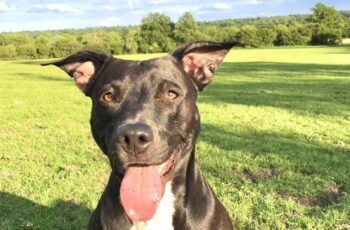
Separation anxiety may be already present in a newly acquired pet’s history (ie., a shelter pet or newly adopted pet), as in some cases it may be the exact reason they were abandoned. However, it can also arise as a secondary or acquired condition, for example, when a dog is suddenly separated from his pet parent following a period of prolonged, constant or exclusive contact or a sudden change in routine. These dogs develop an overly intense attachment and may then be unable to cope with separation. Dogs that are already predisposed to anxiety (firework or storm phobia, for example) are more likely to develop separation anxiety under these circumstances.
SIGNS OF SEPARATION ANXIETY
- Vocalization, destructiveness, and possibly soiling during your absence
- The behavior isn’t apparent when you are home and your dog has access to you
- Destructive behavior is usually focused on doors, confinement areas, pet parent’s possessions
- Continuously seeking contact, departure cue anxiety, excessive greeting and rarely spending independent time alone or outside
- This behavior is apparent while you are home
- In some cases, it may be so severe that the following can also occur:
- Depression and no interest in food during your departure
- Vomiting, diarrhea, and hypersalivation (drooling)
- Inability to settle or stop moving, circling, or pacing
- Excessive licking or grooming (ie., hotspots occur while you are away)
- Restlessness, shivering, shaking
- Signs begin within 30 minutes of your departure, and may not settle for up to an hour, if at all. Sometimes your pet might settle for 15-30 minutes and then cycle with the above signs, settle, and cycle again the entire time you are away.
BEST WAY TO HELP YOUR VETERINARIAN DIAGNOSE THIS CONDITION IF YOUR SUSPECT IT

- Photographs of the destruction while you’ve been gone are helpful
- A video of your pet while you are away is the most useful diagnostic tool
TREATMENT
- There are several forms of pharmaceutical therapies including anti anxiety medications and even natural pheromones. These have few or mixed results when used alone.
- Most effective treatment involves a Behavior Modification Program and training (both the pet parent and the pet) which may or may not involve medication.
PREVENTION
- As with many acquired disorders, prevention is much more preferred, and arguably might be more effective than treatment
- Here are some tips you can do to prevent separation anxiety, or even start addressing it if you catch it early enough. Most of the time it’s what we DON’T do that helps prevent separation anxiety. In general the pet parent is inadvertently reinforcing their anxiety.
The key is to be consistent with this behavior and always try to “catch” them being independent.

-
- Interact with your dog only on your initiative and only when your dog is relaxed.
- Catch them being calm and independent and then go over and reward that. Ignore them or walk away when they are being excessively clingy.
- Train them to stay calm when alone. Train them to sit, lie down or stay as you walk away. Gradually increase distance and time. Treats are great tools for this!
- Give departure cues (keys jingling, packing your belongings, going to the door, maybe even walking out then coming back in) at times other than true departure.

-
- NO DRAMA. Show complete indifference for 20 minutes prior to going out. When you leave, walk out without saying goodbye. Always make leaving “no big deal.”
- Leave a treat-filled toy when you leave and take it away when you return.

-
- NO DRAMA. Ignore excessive greeting until your pet is quiet and relaxed.
- Do not reprimand or punish for any undesirable behaviors. If you are able to ignore the destruction, do so until a later time when you can quietly clean up.
If you are astute at picking up the signs early and are consistent with the tips above, it is unlikely that your pet will develop severe separation anxiety. However, every dog is different, and some highly anxious dogs may need extra help. You can always consider a natural calming supplement like JustFoodForDogs CALM to help improve the effectiveness of the above techniques. If none of these are working, or if you have a difficult case, then please visit your veterinarian or consider a consultation with a board-certified veterinary behaviorist.
Pets provide us so much love, loyalty, and companionship. Sometimes, how we relate to them dictates how they perceive the world around them. We know you love them back, so please realize that even though you are “ignoring” them when you come home and consistently following the above tips, what you are actually doing is calming them in the long run. You are helping them so that you can have more life, more years, and more love with your dog.


